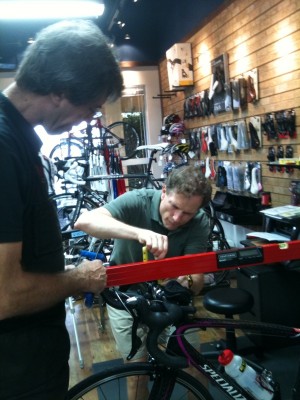At the end of March / beginning of April we went on holiday to Florida, bringing our bikes with us. These two weeks away were a chance for us to get some miles of training under us, and also a chance for me to really take my (now-not-so) new bike on longer rides.
I decided that while we were in the US that a good bike fitting would be a useful investment. You hear people talk about the need to get your bike position checked, looked at, and adjusted so that you can produce more power with less effort and so that you can avoid injuries. We were lucky enough that a bike shop right by my sister’s place offered such a service. And as usual, exchange the pound sign for the dollar and that was the cost – like getting an instant 30% discount!
We went to the Bicycle Lab in Delray Beach Florida for our fitting. Jeff Ruth, an avid cyclist and all around nice guy, helped us with the fitting.
He used the Retul system – basically hooking up various points along our body to electronic sensors, which were then mapped onto his computer so that he could see the angles of our bike form, our movement, and suggest fixes.
The result was a very detailed analysis of my bike fit. Although Jeff’s shop did not have Specialized bikes and they were definitely Cannondale junkies, I walked away thinking my ride and the Specialized shape suited me perfectly. Save for an adjustment to the saddle height, pretty much nothing else needed tinkering with.
The other piece of advice I walked away with was to pay attention to my knee angles. I have typical Shimano SPD cleats, not road shoes, so this means there is little adjustment that I can make to help with my knee angles. Due to my high arched feet I have not found road shoes that would work too well, either. So for now, I just need to build this into my overall awareness of my cycling position.
I know as a novice it is hard to say whether or not the expense for the finest in fitting technology was worth it. But I definitely feel that the seat height and minor adjustments made have all helped me to feel like I am able to generate more power with less effort and strain. Anything that helps me is a good thing!
I would highly recommend a good bike fitting. And thanks especially to Jeff for all of his help.

The guys at The Bicycle Lab, Delray Beach Florida, checking my bike fit.
Note: This service was not provided for free – therefore there is no incentive for me to praise it other than really liking the end result. If you like kit, beware of getting this type of thing done in a shop where they accept plastic. My luggage was a bit heavier from my purchasing. But my legs and body delighted. Thanks again Bicycle Lab.

Your fit was not complete if they did not check your feet – the connection point where you have the greatest chance to have a misalignment causing loss of power, discomfort and possibly allowing you to incur an injury.
Hi, and thanks so much for your comment. I suppose my explanation was a bit brief!
I did have the e-sensors on my shoes and ankles to check foot position. The biggest problem detected was alignment for power stroke. But I wear SPDs which don’t really allow for the perfect cleat adjustment to manage this.
If I was able to switch bike shoes to road style, adjustments could have been made to help my foot position and total leg alignment. But due to the fact that I am in the only shoes that fit over my high arched feet (due to nerve disease) at present, we decided to forego a lot of the major adjusting until I could find a shoe solution (which will probably involve some degree of customisation) that would enable better adjustment.
Thanks for checking!
Donna